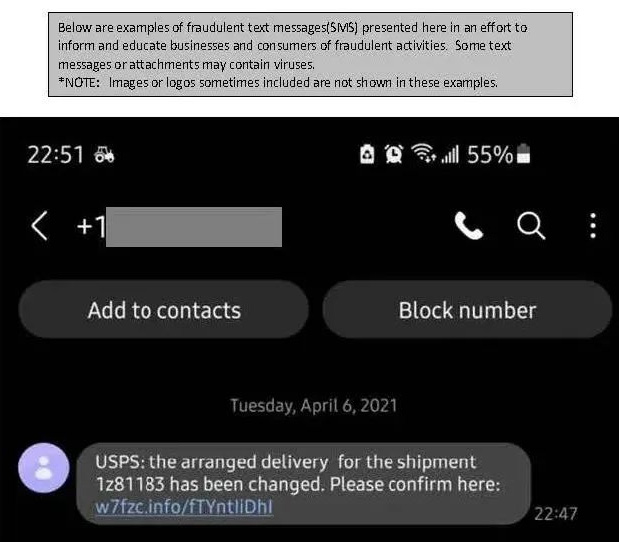
Spam and Phishing Emails
Fraudulent e-mails adopt many different forms and are the unauthorized actions of third parties not associated with UPS. These e-mail messages referred to as "phishing" or "spoofing" are becoming more common and may appear legitimate by incorporating company brands, colors, or other legal disclaimers. Help protect yourself by becoming familiar with these methods of fraud:
Spam: Often referred to as "junk mail," spam consists of e-mail messages that are unsolicited by the recipient and that target the recipient with direct mail messages.
Phishing: The term "phishing," as in fishing for confidential information, refers to a scam in which the sender attempts to fraudulently obtain and use personal or financial information.
Please be advised that UPS does not request payments, personal information, financial information, account numbers, IDs, passwords, or copies of invoices in an unsolicited manner through e-mail, mail, phone, or fax or specifically in exchange for the transportation of goods or services. UPS accepts no responsibility for any costs or charges incurred as a result of fraudulent activity.
Awareness and recognition of fraudulent letters, e-mails and phishing attempts is vital to protecting yourself against theft and other related crimes. Common indicators that an e-mail might be fraudulent include the following:
Design Flaws: An e-mail containing distorted or irregularly sized logos
Poor Grammar: Grammatical errors and excessive use of exclamation points
Misspellings: Incorrectly spelled words or links to altered websites (For example, modifications or variations of the legitimate www.ups.com website address, such as www.unitedparcelservices.com)
Sense of Urgency: Alarming messages requesting immediate action, such as "Your account will be suspended within 24 hours." or "Contact us immediately to claim your parcel or prize."
Unexpected Requests: A request attempting to obtain money, financial information (e.g. bank account or payment card numbers), or personal information in exchange for the delivery of a package or other article
Communication Gaps: An e-mail that does not provide an alternative method for communicating the requested information (i.e. telephone, mail, or physical locations)
Deceptive Link: A link contained within an e-mail that appears to direct your browser to a known, safe site but actually directs your browser to another location, potentially to an unsafe or fraudulent site. You can detect this by hovering over the link with your cursor. This causes the actual destination of the link to display in a pop-up, the lower left of your status bar, or other location depending on your e-mail client. It is suspicious if the actual destination does not match the address in the link. Also be suspicious of links containing numbers in place of letters, abbreviations, and slight misspellings in the link.
Some legitimate UPS communications may come in the form of an e-mail with an "epackage" link contained within the e-mail. These messages are designed to increase the protection around sensitive information, and the associated link will always start with https://ftp2.ups.com.
Fraudulent e-mails often appear to come from trusted sources, with the true sender revealed only through the Internet headers (not the same as the email headers). The Internet headers can be found through your e-mail system from within the e-mail, using various methods depending upon the e-mail system you use. For example, in Microsoft Outlook, this is accomplished by opening the e-mail in a separate window, clicking on the "File" tab and then choosing "Properties." The internet headers will be shown in the box at the bottom of the window.
Additional information on spam or phishing can be found online at the Federal Trade Commission website.
Fraudulent Text Messages, Phone Calls and Other Communications
In addition to fraudulent websites and e-mails, fraudsters also may use the telephone, text messages, a fax machine, letters, or other communication methods in an attempt to gather your personal information.
These fraudulent communications are the unauthorized actions of third parties not associated with UPS. Fraudulent communications claiming to be from UPS may claim to indicate a package is waiting to be delivered.
These communications will generally ask you for personal information and/or a payment in advance of receiving a package, or may indicate a need to update your account by obtaining personal information or a copy of your UPS invoice.
The links in the text messages may contain malware or direct to a fraudulent website.
If UPS contacts you regarding a package, the UPS representative will always be able to provide a tracking number, which you can verify on our website.
You also should know that UPS may contact you from time to time regarding service offerings or for marketing purposes, but you may always verify our phone number and call back before proceeding.
If you are ever unsure of the validity of a communication, ask for the caller's first and last name and a call-back telephone number.
If you are unsure of the validity of a text, do not click or select any links or open any attachments as they may contain a virus.
View Examples of Text Messages
